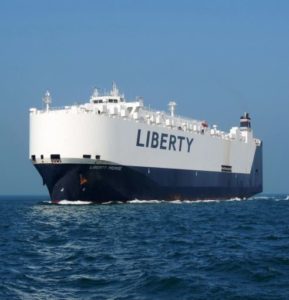A Navy official confirmed Wednesday the service submitted a legislative proposal that would decouple the Navy from having to buy new auxiliary vessels in order to also buy used sealift ships.
“We’ve put forward a legislative proposal that decouples the procurement of the used ships…to get away from the mandate to buy the new ships. That does not mean we are walking away from the construction of new ships, but what it does is it allows us to procure used ships at a faster rate,” Vice Adm. Ricky Williamson, Deputy Chief of Naval Operations for Fleet Readiness and Logistics (N4), said while testifying before the House Armed Services Seapower and Projection Forces subcommittees.

This proposal goes beyond the Navy’s FY 2021 budget request that seeks $60 million to buy two used sealift vessels in FY ’21 and plans to buy another one in FY ’22 while also requesting $37 million in research and development funds to purchase a design for a new ship that would start building in FY ’23 and be delivered in FY ’26.
After the hearing, Williamson further explained the reasoning to reporters.
“Currently, we have a requirement to come back and demonstrate [for the Secretary of the Navy] to Congress to buy 10 ships, so that we can continue to buy the used. What we want to do is we’re not walking away from buying new, we’re absolutely committed to that – that’s the $37 million that we’re asking for in the president’s budget to come up with a plan to develop a ship.”
“What that allows us to do, the decouple – allows us better access to the used market so that we can continue to close the gap that’s been identified in previous studies,” he added.
Williamson confirmed the Navy is still committed to buying new sealift vessels.
“What it does is it allows us to close that gap faster while finding, obviously, the best ship that we can afford within our budget, It allows us to continue to build that…we’re working with the industry, that’s why we’re working with the [U.S. Transportation Command] and the [Maritime Administration] partners, and I think that’s the smartest way forward.”
Williamson said the proposal has been submitted but the Navy has not yet heard anything back from Congress.
Both Navy officials and Congress have said the current estimated cost of buying new sealift vessels at over $500 million per hull is too much.
Rep. Rob Wittman (R-Va.), ranking member of the seapower subcommittee, said he is not confident the government could afford sealift vessels that expensive while building at a pace needed to recapitalize the current aging fleet.
Williamson said they are trying to close the gap between what the Defense Department needs and what it currently has through the three-pronged approach of spending the $60 million on the two used ships in FY ’21, using the $37 million to start working on more affordable designs for new sealift vessels, and extending the life of some current hulls.
Rep. Elaine Luria (D-Va.) pressed Williamson on the total cost of used vessels, saying she heard it may cost more beyond the initial $30 million to also make the used ships usable for sealift purposes.
“That is very important for the committee because if it’s a $30 million price tag to buy this ship but then you need to come back and ask for $30 million more to make it useful for its purpose, we need to know that going into this process.”
Williamson said he would follow up with her on any specific future funding costs.
On Thursday, the Navy’s top acquisition official concurred new sealift vessels are priced too highly.
“From the acquisition side, we’ve got to work together with Congress. The initial cost to replace those as new build ships without some of the initiatives yet in place to revitalize the commercial shipbuilding industry put those ships as very expensive ships. And I don’t believe we want to be putting half a billion dollars into new builds, I don’t think that’s the right strategy,” Assistant Secretary of the Navy for Research, Development and Acquisition James Geurts said before the HASC Readiness subcommittee on March 12.
“We’re doing some near-term mitigations in terms of additional service life extensions and…some purchases of used ones. I think we’ve got to work together to find the right balance. New construction isn’t off the table, but until we can come up with an affordable way to do that, I don’t think replacing that whole fleet with brand new construction ships is going to be the answer either,” Guerts added.